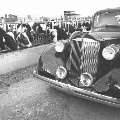|
Re: Generator to Alternator Conversion
|
||||
|---|---|---|---|---|
|
Home away from home

|
Quote:
BTW. ONE wire alternators. If i remeber rite, the one wire alternators are only about 35 amp alternators. I think Motorola makes (made) one too. and Quote: The one wire Delco is suited for low demand applications such as Ag equipment, hot rods, racing vehicles, motorcycles and so forth running only a few different electrical items. You guy's should really leave the hotrodding and modifying to the professionals. 140 amp 1 Wire Alternator I have used 1 wire alternators for years. You can go to almost ANY alternator rebuilding shop and buy the 1 wire regulator for around $10 and convert ANY old style internal regulator Delco alternator to 1 wire. It's simple and easy. The only problem is, they don't charge until around 1500-1800 rpm. You can even get ones up to 200 amps. The hot rodder's have been doing this for years. To put one of these on a Packard, just run the one wire through the amp gauge then to the battery. It works fine. I WILL say however, that they don't seem to last as long as a 3 wire alternator. And if you run a 3 wire alternator, you need a diode harness that plugs in between the alternator and the harness to keep from running your battery down, been there, done that.
Posted on: 2008/2/18 12:54
|
|||
|
||||
|
Re: Generator to Alternator Conversion
|
||||
|---|---|---|---|---|
|
Webmaster
|
On a 3 wire system you have a trigger terminal and also a voltage sensing terminal, plus the main Batt terminal.
First the alternator should not be hooked directly to the battery, it should be attached to the starter battery post. As this is the main junction. Some people just bridge the voltage sensing terminal and the batt terminal together at the back of the alternator. (This is what one-wire system do). This is typically not what you are supposed to do. The voltage sensing should be connected to the where the power feed attaches to the main harness to it can accurately read the voltage load on the system. If you connect it direct to the batt terminal it constantly see full voltage as that is where it is produced, so it is cycling up and down. Also depending on the length of the harness, there is going to be a small difference in voltage between the batt terminal, and the main harness feed. Now the trigger wire needs a load to trigger the alternator on. One wire units do that internally once a certain RPM is reached. If you have a dash idiot light (GEN light), then this become the load to trigger the system, and no diode is needed. On cars without a idiot light, and diode is needed. The way the GEN light works is that when the igintion is turned on 12 volts (or 6 depending on your setup) is supplied from the ignition switch to one terminal on the light, and the other terminal is connected to the trigger on the Alternator. When the alternator is not rotating, the Trigger terminal is supplying a ground path. So the light turns on as visual alert that no power is being produced by the alternator. As the Alternator spins, it start to produce volatge and this also causes the resistance to increases on the trigger termial the Gen light gets dimmer and dimmer, once the voltage being produced by the alternaor is equal too or greater than the voltage at the ignition switch, then the light goes out. For more on 3 wire vs. 1 wire, check this out: madelectrical.com/electricaltech/onewire-threewire.shtml They also have other tech acticles on alternators, and 6>12 volt conversions.
Posted on: 2008/2/18 14:33
|
|||
|
-BigKev
1954 Packard Clipper Deluxe Touring Sedan -> Registry | Project Blog 1937 Packard 115-C Convertible Coupe -> Registry | Project Blog |
||||
|
||||
|
Re: Generator to Alternator Conversion
|
||||
|---|---|---|---|---|
|
Home away from home

|
Kev and Eric, thanks for the links and the better explanations.
Posted on: 2008/2/18 15:30
|
|||
|
||||
|
Re: Generator to Alternator Conversion
|
||||
|---|---|---|---|---|
|
Home away from home

|
Great info! I think I've got what I need to make a decision on making the conversion from Gen to Alt. From looking at my 55 clipper, it appears that it's 12v neg ground already. (that's what it means when the negative batt terminal is grounded to the front of the engine block, right?) All I know is that I know nothing.
Posted on: 2008/2/19 11:41
|
|||
|
||||
|
Re: Generator to Alternator Conversion
|
||||
|---|---|---|---|---|
|
Home away from home

|
I have a 1937 generator for a super eight that's converted to 12 volt.
Does that mean it's automatically negative ground, or do you run 12 volt positive ground?
Posted on: 2015/10/11 10:17
|
|||
|
I can explain it to you but I can't understand it for you
 Bad company corrupts good character! Farming: the art of losing money while working 100 hours a week to feed people who think you are trying to kill them |
||||
|
||||
|
Re: Generator to Alternator Conversion
|
||||
|---|---|---|---|---|
|
Forum Ambassador

|
BDC, generators can function either positive or negative ground, all you have to do is tell them which way you want them to function. And that's done by "polarizing" the unit.
Posted on: 2015/10/11 10:24
|
|||
|
||||








